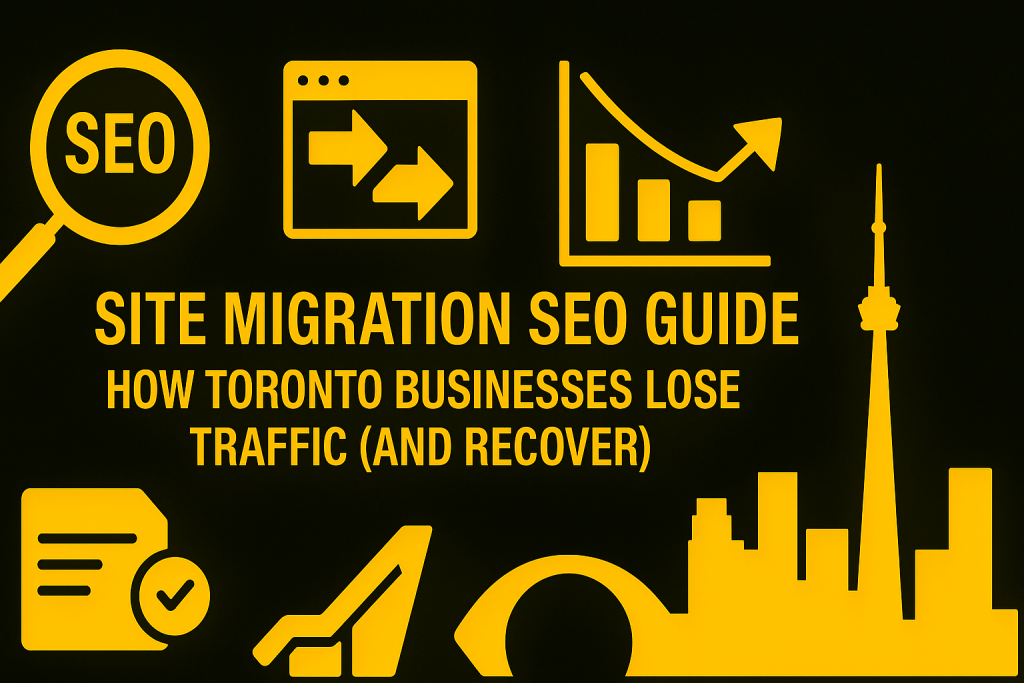When Toronto businesses decide to redesign their website or move to a new domain, one of the most common — and costly — mistakes is losing their hard-earned organic traffic. A poorly planned site migration can wipe out years of SEO equity overnight.
This comprehensive guide will show Toronto business owners, marketers, and web developers how to avoid traffic loss during a site migration, how to recover if it’s already happened, and how to future-proof their SEO performance for 2025 and beyond.
Understanding Site Migration and Why It’s So Risky
A site migration refers to any significant change to your website that affects its structure, content, URLs, or domain. It includes:
Moving from HTTP to HTTPS
Switching to a new domain (e.g.,
.cato.com)Redesigning or rebuilding the site on a new CMS
Merging or splitting websites
Changing URL structures
While these upgrades often aim to improve performance, design, or branding, they disrupt SEO signals that Google uses to rank your website.
If mishandled, you can lose search visibility, backlinks, and trust — sometimes permanently.
Example: A Toronto real estate agency migrated to a new WordPress theme without redirecting its old property listing URLs. Within weeks, it lost over 70% of its organic leads.
The SEO Impact of a Bad Site Migration
1. Loss of URL Equity
When you change URLs without setting up 301 redirects, Google sees new pages as brand-new — with no history, authority, or backlinks attached.
Your domain authority plummets, and old links from directories or blog posts point to broken pages, resulting in 404 errors.
2. Indexing Issues
If your new site blocks crawlers in robots.txt or lacks a sitemap update, Google may de-index your site entirely. This leads to a sharp decline in organic visibility.
3. Content Mismatch
Changes in page titles, metadata, or content depth confuse search engines. Pages that once ranked for valuable local Toronto keywords like “SEO company near Yonge Street” or “Toronto eCommerce web design” may vanish from search results.
4. Internal Linking Loss
Internal links are SEO’s silent powerhouse. During migration, if your internal linking structure breaks, link equity stops flowing through your site.
Toronto SEO experts often rebuild this structure using detailed content silos — a method covered in Content Optimization: Boosting Engagement and Rankings.
Pre-Migration SEO Checklist for Toronto Businesses
A successful site migration requires meticulous planning. Below is a proven SEO migration checklist that Toronto agencies follow.
1. Crawl Your Current Website
Use tools like Screaming Frog or Sitebulb to capture your entire website structure:
All indexed URLs
Meta titles and descriptions
Canonical tags
Image alt attributes
Redirect chains
This serves as your baseline for comparison.
2. Benchmark SEO Metrics
Record performance metrics before migration:
Organic traffic (Google Search Console)
Keyword rankings
Top landing pages
Backlink sources (Ahrefs, SEMrush)
This helps measure recovery success later.
3. Map Old URLs to New URLs
Create a 301 redirect map to ensure all authority passes smoothly. Every old URL should have a one-to-one mapping to its new version.
Toronto agencies like those mentioned in Top 10 Toronto SEO Agencies Ranked by Performance use automated scripts to detect missing redirects before launch.
4. Preserve Content Quality
Do not delete high-performing blog posts or service pages. If redesigning, keep metadata, headings, and structured data intact. Even slight content shifts can derail rankings.
5. Audit Technical Health
Check:
HTTPS certificates
Canonical tags
Schema markup
XML sitemap and
robots.txtMobile-friendliness
Core Web Vitals
You can explore how to optimize these elements in Core Web Vitals Toronto Edition: Real Fixes That Boost Ranking.
During Migration: SEO Practices to Protect Rankings
1. Launch on a Staging Environment
Always test your new site in a staging area before going live. This ensures redirects, internal links, and meta tags are working.
2. Use Temporary Noindex Tags
Add a temporary noindex tag on the staging version to prevent Google from indexing it prematurely. Remove the tag before the official launch.
3. Verify Redirect Chains
Avoid redirect loops and multi-step chains. Every redirect should lead directly from old to new URL — no detours.
4. Update Your Sitemap and Robots.txt
Submit a new sitemap in Google Search Console immediately after migration. Ensure that your robots.txt allows crawling of your new URLs.
Post-Migration Recovery Strategy
Even with careful planning, Toronto businesses often see temporary dips in rankings post-migration. Recovery is possible with the right strategy.
1. Monitor Google Search Console
Use the Coverage and Performance reports to identify:
Indexed vs. excluded pages
404 or soft 404 errors
Keyword position changes
Address these within days to avoid prolonged ranking drops.
2. Check Crawl Errors and Redirects
Use log analyzers or tools like Ahrefs’ Site Audit to confirm Googlebot is crawling the new URLs efficiently.
3. Rebuild Internal Link Structure
Internal links must direct to the new URLs. Pages like your service listings, blog posts, and contact page should interlink logically.
See how Toronto agencies use AI-driven internal linking in AI-Powered SEO for Toronto: Clusters & Briefs.
4. Submit Reindex Requests
After correcting major issues, use the URL Inspection Tool in Google Search Console to reindex high-value pages faster.
5. Reclaim Lost Backlinks
If your backlinks point to outdated URLs, reach out to linking sites for updates. Prioritize authoritative sources like Toronto business directories or media publications.

How to Recover Lost Organic Traffic After a Failed Migration
If your Toronto business already suffered a traffic crash, you can recover with a structured plan.
1. Identify Lost Pages
Use analytics tools to find which pages had the biggest traffic drops post-migration. Restore their content or redirect them properly.
2. Optimize for Local SEO Again
Your Google Business Profile and local citations might still point to old URLs. Update them to regain your local visibility.
Check out Local SEO Tips for Toronto Businesses: Rank in the Google 3-Pack.
3. Strengthen Topical Authority
Publish new blog content around your primary Toronto keywords to rebuild relevance. Topics like “SEO cost in Toronto 2025” or “Google AI search changes” attract new traffic quickly.
For ideas, visit Toronto SEO Trends in 2025: What the Latest Data Reveals.
4. Use Structured Data and Schema
Adding schema markup helps Google understand your site faster and improves click-through rates. Consider using the Schema.org guide for validation.
5. Rebuild E-E-A-T Signals
Google rewards websites that show Experience, Expertise, Authoritativeness, and Trust. Add author bios, business addresses, and updated reviews to regain credibility.
Toronto Case Study: A Local Business That Bounced Back
A Toronto dental clinic migrated from Wix to WordPress in 2024. Despite careful design updates, it lost 60% of its organic traffic within 3 weeks.
After auditing the migration, the following issues were found:
Missing redirects for blog posts
Duplicate title tags
Slow mobile load times
Outdated sitemap
By implementing 301 redirects, compressing media, updating sitemaps, and using WordPress Technical SEO Audit Toronto, the clinic recovered 95% of its traffic in 60 days and even improved conversions by 22%.
Best Practices to Future-Proof Your Next Migration
1. Keep a Continuous Backup
Always store historical SEO data and previous versions of your site. You might need to revert or cross-reference older structures.
2. Maintain Content Silos
Organize your site by topics — service, industry, or city pages. Learn how in Content Silos Toronto: Structuring for Authority.
3. Plan SEO Testing Periods
Run controlled A/B testing for title tags, CTAs, and layouts. Toronto SEO agencies often dedicate 2–3 weeks post-launch for testing before scaling updates.
4. Use AI-Powered Migration Tools
Leverage machine learning-based audit systems that can predict migration risks and automate redirect checks.
Regaining Your Competitive Edge
After recovery, Toronto businesses should focus on regaining lost rankings through AI SEO strategies. Tools now identify emerging keywords, competitor gaps, and search intent shifts before your rivals do.
To stay competitive, explore AI SEO Toronto: Leveraging Machine Learning for Smarter Keyword Targeting.
When to Hire a Professional Toronto SEO Agency
If migration or recovery feels overwhelming, working with a local expert can prevent costly errors.
A professional team will:
Audit your site architecture
Execute safe redirects
Restore backlink profiles
Track and report every ranking change
See the benefits of partnering with experts in Hiring a Toronto SEO Expert vs Doing It In-House: Pros & Cons.
Conclusion
A site migration is more than just a design change — it’s a high-stakes SEO operation. Toronto businesses can either emerge stronger with improved rankings or lose years of online authority overnight.
By preparing strategically, auditing thoroughly, and restoring SEO signals post-launch, you can retain your traffic, strengthen your brand visibility, and set the stage for future growth.
For tailored assistance with your next migration or SEO recovery project, reach out through our Contact Page.
Frequently Asked Questions
1. How long does SEO recovery take after a site migration?
Most Toronto sites recover within 4–12 weeks, depending on redirect accuracy and crawl frequency.
2. Can I migrate to a new domain without losing SEO?
Yes — if you use proper 301 redirects, update all internal links, and inform Google via the Change of Address Tool.
3. What’s the difference between 301 and 302 redirects?
A 301 redirect is permanent and passes link equity. A 302 redirect is temporary and does not.
4. Should I keep old pages live after migration?
Only for testing. Once confirmed, redirect or remove them to avoid duplicate content issues.
5. What is the biggest mistake Toronto businesses make during migration?
Not consulting an SEO specialist before launching the new site. This oversight often leads to indexing and ranking disasters.


